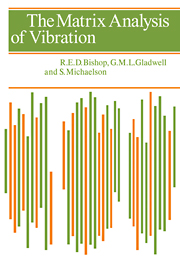Book contents
- Frontmatter
- Contents
- Preface
- Chapter 1 Notation and elementary properties of matrices
- Chapter 2 The vibration of conservative systems having a finite number of degrees of freedom
- Chapter 3 Linear equations
- Chapter 4 Further development of the theory of conservative systems
- Chapter 5 Damped forced vibration
- Chapter 6 Continuous systems
- Chapter 7 The solution of linear equations and the inversion of matrices
- Chapter 8 Iterative methods for characteristic value problems
- Chapter 9 Direct methods for characteristic value problems
- Appendix
- Answers to examples
- Index
Chapter 6 - Continuous systems
Published online by Cambridge University Press: 24 November 2009
- Frontmatter
- Contents
- Preface
- Chapter 1 Notation and elementary properties of matrices
- Chapter 2 The vibration of conservative systems having a finite number of degrees of freedom
- Chapter 3 Linear equations
- Chapter 4 Further development of the theory of conservative systems
- Chapter 5 Damped forced vibration
- Chapter 6 Continuous systems
- Chapter 7 The solution of linear equations and the inversion of matrices
- Chapter 8 Iterative methods for characteristic value problems
- Chapter 9 Direct methods for characteristic value problems
- Appendix
- Answers to examples
- Index
Summary
…. To understand it, cling passionately to one another and think of faint lilies.
PatienceThe theory of vibration which is presented in the previous chapters relates to an idealised vibrating system having a finite number of degrees of freedom. This chapter is concerned mainly with continuous systems, that is, systems with an infinity of degrees of freedom. First it will be shown how receptances may be defined for continuous systems, then it will be shown how composite systems, whether continuous or discrete, may be analysed by the use of matrices. Finally, it will be shown how the theory developed for systems with a finite number of degrees of freedom may be applied to the vibration of continuous systems.
Throughout this chapter only undamped vibration will be discussed. But the reader will observe that much of the analysis may be generalised to cover damped vibrating systems. Throughout this chapter, therefore, all displacements and forces will be harmonic, and will have the same frequency and phase.
The receptances of continuous systems
The receptances of a discrete system—that is, a system with a finite number of degrees of freedom—were defined in § 2.2. Although they were first introduced as elements of the receptance matrix, their fundamental meaning is such that the receptance αxy gives the displacement at the coordinate x due to a harmonic force at the coordinate y.
- Type
- Chapter
- Information
- The Matrix Analysis of Vibration , pp. 176 - 251Publisher: Cambridge University PressPrint publication year: 1979

